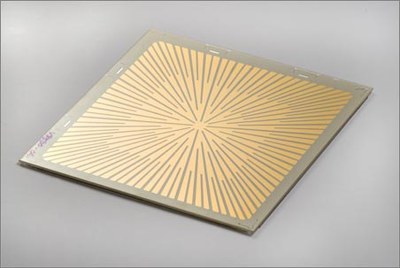The OLLA Project - Final Milestone: Europe’s Most Efficient OLED Lighting Tile Demonstrated
At the end of the project period, the OLLA project* consortium presents its final milestone: the basic technology for a white OLED (Organic Light-Emitting Diode) light source, with an efficacy of 50.7 lumens per watt at an initial brightness of 1.000 cd/m² based on the Novaled PIN OLED technology. The OLLA project is a joint basic research consortium, headed by Philips Lighting.
The OLED technology is generating a novel and very attractive class of solid-state light sources, which are flat, thin, and very lightweight. Due to its freedom of design, OLED lighting technology offers many possibilities for new lighting applications achieving substantial energy savings. Within OLLA 24 partners of 8 European countries have been working closely together developing OLED technology for lighting purposes with the goal to reach an efficacy of 50 lumens per watt combined with a lifetime of over 10.000 hours at 1.000 cd/m2 initial brightness.
Philips Research and Novaled, together with the partners reached the project targets in efficacy, color rendering and brightness. The lifetime of the Novaled device even exceeded the promised value by one order of magnitude.
"The high efficiency combined with the extrapolated lifetime values prove that OLED is a serious technology for lighting applications, allowing innovative design capabilities and energy savings for future lighting products. It is a very important step towards the introduction of OLED technology in the lighting market," says Peter Visser, Project Manager OLLA project, Philips Lighting.
“The Novaled PIN technology has the potential to further improve the power efficiency. It’s in line with the technology roadmap that in the near future some 100 lm/W OLEDs will be achievable”, adds Dr. Martin Vehse from Novaled.
“Collecting all light of the device in a laboratory set-up with a macro extractor, we measure even more than 80 lumens per Watt”, comments Dr. Volker van Elsbergen, Philips Research, the achievement. "This shows that one of the keys to higher efficiencies will be better light outcoupling technologies.”
Besides the record values listed above, the OLLA project delivered the first large sized ITO-free OLEDs, the first large-area printed OLEDs and several ICT demonstrators. All demonstrators were on show in June 12, 2008 on a public event in Eindhoven.
Philips, Osram Opto Semiconductors, Siemens, Novaled and Fraunhofer IPMS will continue the development of OLED lighting technology in a follow-up project. Within this new OLED100.eu project, the efficiency, lifetime and size of OLEDs will further increased.



